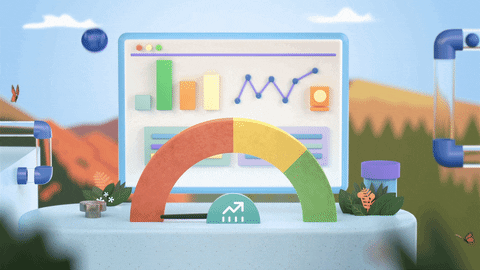Services List
Advertising is a great way to bring qualified traffic to your site quickly. But what happens when your advertising efforts start to plateau? How do you get to the next level? Journey-Based advertising, that's how!

You, the advertiser, have the power to make campaigns more engaging and, in the process, lower your cost-per-click (CPC) to get more results. It sounds like magic, but it’s not: it’s called journey-based advertising.
Journey-based advertising is your key to standing out in a saturated online space. Traditional pay-per-click (PPC) ads are kind of spammy and unhelpful, and you’re likely paying an arm and a leg for ads with modest or any return on investment (ROI) anyway.

What Is Journey-Based Advertising?
If you’re an inbound marketer like us, you probably have all kinds of misconceptions about paid advertising. Maybe you think it’s always disruptive, it’s not helpful, the ROI isn’t there like it is for inbound, or you feel a little slimy using an outbound tactic like paid ads. In this article, we’ll dispel those myths, explain exactly what this journey-based advertising means, and how you can apply it to your digital marketing efforts.
Journey-based advertising is a paid advertising strategy that helps your buyer persona make a purchasing decision along the buyer’s journey by answering questions and providing resources and offers that align with the awareness, consideration, and decision stages of the buyer’s journey. Journey-based advertising provides a better user experience for your buy persona than other paid advertising strategies and a greater return on investment for the advertiser. Let’s decipher this definition step by step.
Why Do I Need To Use Journey-Based Advertising?
Everything starts with people who buy from you. We call your typical buyer, your buyer persona. Your buyer person includes demographic information:
- Age
- Sex
- Location
- Education level
- Etcetera
As you dig deeper into how this impacts your marketing, you will be able to tease out what devices they are on, for what purpose, and when. This has a direct impact on when you show ads and your bid strategy. Maybe you should bid down on ads in apps at 3:30 in the afternoon because your buyer persona handed over the cell phone to the kids on the ride home from school? Or bid aggressively on mobile when you know your buyer persona is stuck in status meetings they don’t really want to be in.
And also a psychographic profile:
- Interests
- Challenges
- Goals
- Fears
- Etcetera
Psychographic information is the perfect place to start split testing ads. Let’s say you’re an addiction treatment provider. You could run an ad focused on a life with gainful employment and free from the lies and destructive behavior that characterizes active addiction or their fear that their children could be taken away from them. One ad focuses on the prospect’s goals and the other their fears.
If you haven’t taken the time to develop your buyer personas, bookmark our post on how to create a buyer persona for later reference. But the buyer persona is just part of the story. Besides knowing who your buyers are and what’s important to them, you also need to understand the process that they go through from becoming aware of their problem to choosing you as their solution.

How Do I Use Journey-Based Advertising?
We recommend creating 3 campaigns: one for each stage of your buyer’s journey (Awareness, Consideration, and Decision). This way, you can create hyper-focused ads tailored to what buyers need to see, when they want to see it.
Dive into the buyer’s journey to see how you can make journey-based advertising a reality for your campaigns.
- Awareness stage
- Consideration stage
- Decision stage
During the Awareness stage, your buyer realizes they have a problem. At this stage, it’s critical for advertisers to understand buyer pain points and deliver ads addressing those pain points.
For Awareness content, write ads that position you as a trusted authority in the space. Don’t jump straight into promoting your product pages. Instead, promote free resources like blogs, whitepapers, and any other helpful piece of content that your buyers want to see right now.
In this stage, focus on engagement metrics like impressions and click-through rates. Your best bet for attracting Awareness stage buyers is through display ads, video, native social media promotions, and boosted posts.
Next is the Consideration stage. This is the point at which your buyer persona considers broad categories of solutions. The buyer looks at comparisons and general information about individuals solutions to help them make a decision. They aren’t ready to buy yet, but your brand is on their radar as a potential contender. This is your chance to come in with hyper-relevant ads that deliver value.
Not sure how to distinguish Awareness buyers from Consideration buyers? On many ad networks, it’s all about keywords and other targeting methods. Instead of focusing on high-level keywords like “what is marketing,” Consideration-stage campaigns should focus on more pointed keywords like “inbound versus outbound marketing” or “example digital marketing campaign plans.”
At this stage, your PPC ads should share content comparing your products and services to other solutions. Retargeting is a great way to put this content in front of interested buyers who saw you during the Awareness stage, too. Sponsored content in social media newsfeeds and retargeting campaigns are especially effective in this stage.
The final stage of the buyer’s journey is the Decision stage. This is the point where your buyer whips out their credit card and chooses a solution to their problem.
You want to target keywords that focus on pricing and product features. Focusing on keywords like “near me” or “buy” targets Decision stage buyers, too. Ads with coupons, demos, promotions, and consults sweeten the deal for your potential buyer.
At this stage, you can get a little more disruptive and promotional. Try non-skippable ads, prominent display ads, call ads, and retargeting to connect with more Decision-stage buyers. Now’s the time to do a hard sell on your features and pricing.

-3.png?width=800&name=Discover%20if%20CRM%20is%20fit%20for%20your%20business%20(1)-3.png)
-Jan-22-2024-10-53-58-8806-AM.png?width=1200&name=CRM%20System%20(1)-Jan-22-2024-10-53-58-8806-AM.png)

